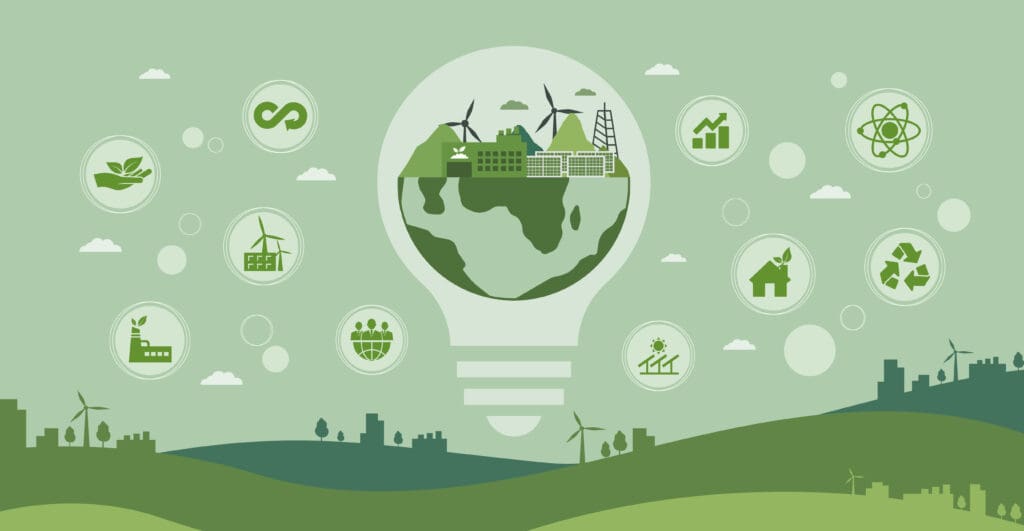Harnessing the Power of Climate Tech to Drive Environmental Sustainability
In a world grappling with the urgent need to combat climate change, harnessing the power of climate tech has emerged as a beacon of hope for environmental sustainability.
From renewable energy to carbon capture and beyond, the potential of technological advancements to mitigate the effects of our carbon footprint is awe-inspiring.
But how can organizations effectively implement this groundbreaking tech?
Delve into the realm of climate tech and uncover the key roles and people driving its implementation and management.
Climate tech implementation quick reference:
- What is climate tech?
- Climate tech examples
- Implementing climate tech in organizations
- Key roles for implementing climate tech
- Future environmental sustainability trends
What is climate tech?
Climate tech refers to the array of modern technologies designed to mitigate the impacts of climate change and contribute to environmental sustainability. It spans a broad spectrum, including renewable energy technologies like solar and wind power, carbon capture and sequestration systems, and climate-resilient infrastructure.
These technologies aim to reduce greenhouse gas emissions and help societies adapt to a changing climate while promoting sustainable growth.
There is a significant surge in climate tech innovations, with trends pointing towards advancements in battery technologies, smart grids, and artificial intelligence for climate modeling.
9 climate tech examples
1. Renewable Energy Technologies
These include solar panels, wind turbines, hydroelectric power, and geothermal energy systems. They generate electricity from renewable sources, reducing reliance on fossil fuels.
2. Energy Storage Solutions
Technologies like lithium-ion batteries, flow batteries, and other forms of energy storage are crucial for balancing the grid, especially with the intermittent nature of renewable energy sources.
3. Smart Grid Technology
Smart grids use digital communications technology to manage and distribute energy more efficiently, integrating renewable energy sources and improving the reliability of the power supply.
4. Energy-Efficient Building Technologies
These include advanced insulation materials, energy-efficient lighting and appliances, and smart home systems that reduce energy consumption in buildings.
5. Sustainable Water Management Systems
Technologies for water conservation, efficient irrigation, and wastewater treatment help manage water resources sustainably.
6. Climate Monitoring and Modeling Software
Advanced software and AI algorithms are used for climate modeling, weather forecasting, and tracking environmental changes, aiding in climate research and policy-making.
7. Green Hydrogen
Produced using renewable energy, green hydrogen is an emerging fuel that can be used in various sectors, including transportation and industry, without emitting carbon.
8. Biodegradable Materials and Circular Economy Solutions:
Innovations in materials science that lead to biodegradable or recyclable products support a circular economy, reducing waste and resource consumption.
Afforestation and Reforestation Technologies: Tools and techniques supporting tree planting and forest management help in preserving carbon sequestration and biodiversity.
Implementing climate tech in organizations
Implementing climate tech in organizations involves assessing needs and goals, building a skilled climate tech team, implementing environmental sustainability strategies, ongoing management and maintenance, and measuring and reporting impact.
Assessing organizational climate tech needs and goals
An organization’s goals could range from reducing carbon emissions to improving resource efficiency or shifting to renewable energy sources.
A comprehensive sustainability audit is indispensable in understanding the organization’s current environmental impacts and pinpointing areas for improvement.
Subsequently, it’s crucial to align the chosen climate tech solutions with the organization’s business objectives to ensure cohesiveness in operations.
Lastly, assessing financial and resource constraints is essential for determining the feasibility of the tech implementation and strategizing for potential challenges.
Building a skilled climate tech team
The implementation of climate tech necessitates the formation of interdisciplinary teams encompassing individuals with skills in technology, environmental science, and business.
Such a versatile team can seamlessly integrate climate tech into business operations, aligning environmental sustainability goals with business objectives.
Organizations can train existing staff members to handle climate tech or hire new talent with specialized skills.
In addition, collaborating with external experts, consultants, and technology providers can offer valuable insights and support during the integration process and help overcome any technical or operational challenges.

Implementation of environmental sustainability strategies
Implementation of climate tech solutions generally begins with an in-depth feasibility study, followed by selecting suitable technology aligned with the organization’s climate goals.
Next, the team develops and executes a detailed implementation plan, ensuring the seamless integration of the tech into existing operations.
However, organizations often face challenges such as financial constraints, technical difficulties, and resistance to change during tech implementation.
These hurdles can be overcome by securing adequate funding, providing employee training and support, collaborating with tech experts for technical issues, and fostering a company culture that embraces change and innovation for sustainability.
Ongoing management and maintenance
Once the climate tech systems are in place, roles such as data analysts and system engineers become pivotal in monitoring, managing, and optimizing these technologies.
Data analysts are responsible for assessing the performance and impact of implemented solutions, while system engineers ensure the seamless and efficient operation of these technologies.
It’s essential for organizations to foster an ethos of continuous improvement, keeping abreast with emerging technologies and making necessary upgrades to stay at the forefront of climate tech.
Measuring impact and reporting
To measure the impact of climate tech, organizations can employ various tools and methods such as carbon accounting software, energy management systems, and IoT-enabled sensors for real-time data collection.
These tools help quantify carbon emissions, energy consumption, waste generation, and other environmental metrics, providing a measurable indication of the technology’s effectiveness.
Data scientists and analysts play a crucial role in interpreting these results, leveraging advanced analytics and machine learning algorithms to discern patterns, trends, and insights that can guide future strategies.
Transparent reporting of these findings to stakeholders, including employees, investors, and the public, is crucial, as it not only reinforces accountability but also fosters trust and engagement in the organization’s sustainability journey.
Key roles for implementing climate technologies
Key roles for implementing climate technologies include several subject matter experts across IT and tech, digital marketing, and cross-functional roles.
IT and tech roles for implementing climate tech
- Climate Technology Specialist: Responsible for selecting, implementing, and optimizing climate tech solutions.
- Sustainability Data Analyst: Specializes in collecting, analyzing, and interpreting environmental data for sustainability strategies.
- Renewable Energy Systems Engineer: Responsible for designing and maintaining renewable energy solutions like solar panels or wind turbines.
- Environmental IT Consultant: Advises on the best IT practices and technologies to reduce the organization’s carbon footprint.
- Green Software Developer: Develops applications and systems optimized for energy efficiency and minimal environmental impact.
- Sustainability Integration Manager: Ensures climate tech solutions seamlessly integrate with existing IT infrastructure.
- IoT (Internet of Things) Engineer: Implements and manages IoT solutions for monitoring and reducing energy usage.
- AI and Machine Learning Specialist: Utilizes AI and ML for predictive analysis and optimization of environmental sustainability measures.
Digital marketing roles for implementing climate tech
- Sustainability Content Creator: Develops engaging content that highlights the organization’s sustainability efforts and climate tech initiatives.
- Green Branding Specialist: Focuses on branding and positioning the organization as a leader in environmental sustainability.
- SEO and SEM Specialist: Enhances online visibility for the organization’s sustainability initiatives through search engine optimization and marketing.
- Social Media Manager: Manages social media platforms to promote sustainability practices and engage with eco-conscious consumers.
- Digital Outreach Coordinator: Builds partnerships and networks with online communities, influencers, and platforms focused on sustainability.
- Email Marketing Specialist: Creates targeted email campaigns to educate and update subscribers about the organization’s climate tech advancements and sustainability efforts.
- Data-Driven Marketing Analyst: Analyzes digital marketing data to optimize campaigns for greater impact on sustainability messaging.
- Video and Multimedia Producer: Creates visual content like videos, infographics, and interactive media to communicate the organization’s sustainability narrative effectively.
Cross-functional roles for implementing climate tech
- Project Manager for Sustainability Initiatives: Oversees the planning, execution, and tracking of sustainability projects, ensuring they align with the organization’s goals.
- Corporate Social Responsibility (CSR) Communicator: Bridges the gap between technical teams and the public, communicating CSR initiatives effectively.
- User Experience (UX) Designer for Sustainability Apps: Designs user-friendly digital interfaces for apps and tools related to sustainability.
- Training and Development Specialist: Educates employees about sustainability practices and the use of climate tech in their roles.
4 future environmental sustainability trends
Future environmental sustainability trends include carbon capture and storage (CCS), precision agriculture, electric vehicles, and the circular economy.
1. Carbon Capture and Storage (CCS)
Carbon capture and storage (CCS) involves capturing carbon dioxide emissions from industrial processes, transporting them to a storage site, and securely storing them underground.
This clean technology can significantly reduce carbon emissions from power plants, cement factories, and other polluting industries.
2. Precision agriculture
Precision agriculture uses data-driven technologies such as sensors, drones, and machine learning to optimize agricultural practices.
This technology helps reduce the use of pesticides and fertilizers, increase crop yields, and conserve water resources.
3. Electric vehicles
Electric vehicles (EVs) are gaining popularity as a sustainable alternative because the transportation sector is a major contributor to greenhouse gas emissions.
The development of better batteries, faster charging technology, and increased affordability make EVs a viable option for reducing carbon emissions from transportation.
4. Circular economy
The circular economy model aims to eliminate waste and promote resource efficiency by designing products that can be reused, repaired, or recycled.
This approach reduces the environmental impact and creates economic opportunities and new business models.
The climate tech landscape
Climate technology plays a pivotal role in achieving environmental sustainability, allowing us to measure, manage, and reduce our environmental impact on an unprecedented scale.
By harnessing the power of climate tech, organizations can move beyond mere regulatory compliance to pioneer innovative climate solutions for carbon neutrality.
It is imperative for organizations to take proactive steps in implementing and effectively managing climate tech, thereby reinforcing their commitment to the planet’s well-being.
With the business world uniquely positioned to make a significant positive impact, the time to act is now, which is why it’s imperative for businesses to assess their current sustainability practices, identify areas for improvement, and consider how climate tech can help meet and exceed those objectives.
Looking to hire top-tier Tech, Digital Marketing, or Creative Talent? We can help.
Every year, Mondo helps to fill over 2,000 open positions nationwide.
More articles about hiring and industry trends:
- Staffing Strategies For Each Phase of the Business Cycle
- How to Leverage Tech and Digital Marketing for Back-of-House Hospitality
- Key Roles to Get the Most Out of Your MarTech Stack
- Tapping the Gig Economy: When It Makes Sense to Hire Contractors
- How to Boost Your 2023 Holiday Shopping Profits With AI
- How Executive Recruiters Ease Your Hiring Process
- What to Do When You Have Urgent Hiring Needs
- Ultimate Year-End Management Checklist for Leaders to Ring in The New Year
- Generative AI & Its Impact on the Job Market: It’s Not All Bad News
- The Rise of Working Moms & the Role of Remote Work
- How to Recruit Top Data Scientists in a Competitive Job Market
- Lessons From Unicorn Companies: Hiring Strategies for Rapid Growth



